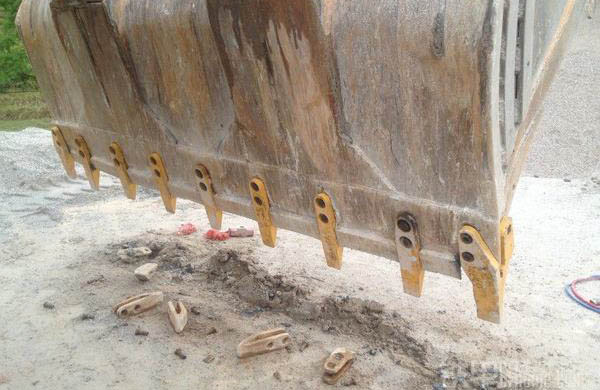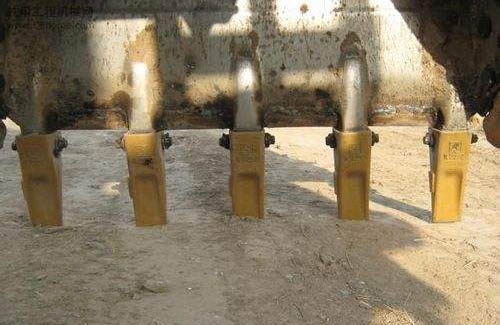 Daily maintenance of the bucket tooth
Daily maintenance of the bucket tooth
The bucket tooth on the sides of the bucket are generally abrase faster than the bucket tooth on the middle of the bucket. When the bucket tooth on the sides are much shorter than the middle bucket tooth, the swap positions between the sides and the middle can be used continuously. It can reduce the number of repairs and indirectly increase the service life of the tooth. Before the tooth wear reaches the limit of use, it is good to weld the tooth in time. In addition, the tooth of different materials are suitable for rock of different hardness. There is no tooth made of one material suitable for any working environment, so it is necessary to select the tooth according to different working media.
Excavator tooth with wear-resistant surfacing repair have high wear resistance, and their service life can be increased by 3 to 4 times, and the cost of surfacing is much less than the cost of replacing new tooth. And an old tooth can be repaired and used many times, that is, after the wear-resistant surfacing layer is worn away, the surfacing repair can be performed again until the whole is scrapped, which greatly saves the production cost. In addition, when the newly-changed tooth works in a harsh working environment and is subjected to a particularly strong impact load, it can also be welded on the surface of the new tooth to increase its wear resistance and increase the service life. Since surface surfacing reduces the requirements on the tooth base material, thereby reducing the material cost, and bringing high economic benefits to both the manufacturer and the user, it is worth promoting.
20-032020
 Wear failure mechanism of bucket tooth
Wear failure mechanism of bucket tooth
The wear failure mechanism of bucket tooth is related to material and working conditions, mainly including micro-cutting, fatigue spalling and other mechanisms. Generally speaking, micro-cutting wear mechanism plays a dominant role in the wear process of bucket tooth, up to 70%. With the increase of the hardness of bucket toot, the fatigue spalling mechanism increases gradually, accounting for 20-30%. When the material hardness reaches the upper limit, brittleness increases and brittle fracture may occur. In the case of micro-cutting wear mechanism, improving the hardness of the bucket tooth material is beneficial to improving its wear resistance; for the fatigue spalling mechanism, the material is required to have a good combination of hardness and toughness; high hardness, high fracture toughness, low crack growth rate and high impact fatigue resistance are beneficial to improving the wear resistance of the material.
I. Micro-cutting mechanism
When bucket tooth interact with rocks under high impact load, on the one hand, they contact with the surface of rocks (ores) and produce greater impact force. If the yield strength of bucket tooth is low, plastic deformation will occur at the tip of bucket tooth, thus forming plastic plough grooves. On the other hand, when the bucket tooth are inserted into the rock if the bucket tooth hardness is lower than the rock hardness, the rock particles are pushed into the bucket tooth surface, which will produce long curved or spiral chips, forming cutting grooves, and may be accompanied by micro-cutting debris. Chips are deformed by shearing, resulting in a large amount of latent heat of deformation, compact and orderly sliding steps and wrinkles. In addition, the friction heat between chips and rocks produces friction heat. The combined effect of latent heat of deformation and friction heat makes chips temperature rise sharply, dynamic recrystallization, tempering softening and dynamic phase transformation occur, which changes the internal structure of chips. Some of them also have partial melting.
2. Fatigue spalling mechanism
The bucket tooth insert into the rock for reciprocating motion. The plastic plough formed on the surface of the bucket tooth can be rolled by rock particles for many times to form a metal multi-flow platform. When the stress on the bucket tooth exceeds the strength limit, cracks and brittle cracks will occur and become debris. The debris is split perpendicular to the direction of wear and tear off along the direction of wear. The front of the debris is smooth groove stripe, the back is flat, and the side is overlapping stripe formed by rolling deformation. If the rock has edges and corners, it will shear the deformed layer and form debris, which is flat and thin, with rough edges. In another case, when the bucket tooth interact with rock repeatedly, the bucket tooth produce plastic deformation and cause high work hardening, which increases the brittleness of the bucket tooth surface. Under the strong impact of rock, the bucket tooth surface will form brittle fragments, and the surface of the bucket tooth will have radial cracks of different depths. Strictly speaking, this brittle crack feature is also the mechanism of fatigue spalling.
19-032020
 Selection of Bucket Tooth Welding Materials
Selection of Bucket Tooth Welding Materials
In order to improve the wear resistance of bucket tooth, it is necessary to select reasonable welding materials during surfacing. The selection principle of surfacing welding material for high manganese steel base material is to select surfacing alloy material with high hardness and good wear resistance as long as it can withstand material impact and large impact load during use. For example, the surface surfacing of the bucket tooth, which are used in the working environment with very strong impact, should use the austenitic manganese steel surfacing alloy material.
Most of the matrix materials of bucket tooth are austenitic high manganese steel (steel No. ZGMn13), so EDMn-B-16 (brand D266) high manganese steel surfacing electrode is selected for welding repair. The filling metal of this kind of electrode is austenitic high manganese steel, and molybdenum is added to the filling metal, which improves the crack resistance and wear resistance of the weld metal. Therefore, the surface of the bucket tooth after surfacing with this electrode has the characteristics of work hardening, high toughness and good wear resistance. The hardness of the surfacing metal surface can reach HB < 170.
Because ZGMn13 belongs to high carbon steel, its weldability is poor: on the one hand, carbides are easy to precipitate in the heat affected zone of welding, which leads to material embrittlement; on the other hand, the tendency of hot cracking in weld is serious, especially in the near weld zone, which is prone to liquefaction cracking. Therefore, before welding, reasonable welding process should be formulated to ensure the quality of surfacing metal layer and reduce the occurrence of welding defects.
18-032020
 Optimization in the Structure of Bucket Tooth
Optimization in the Structure of Bucket Tooth
Many bucket tooth wear failures are caused by unreasonable design of structure. Therefore, in order to improve the wear resistance of bucket tooth, the structure morphology can be changed.
In the overall structure, the long groove can be changed into a round hole, which can not only achieve the effect of anti-wear, but also improve the phenomenon of stress concentration. At the same time, the bucket lip bucket tooth and bucket tooth angle should be reasonably designed. If the bucket tooth angle is too large, it will increase the bending impact stress, thus causing bucket tooth to break. If the angle between the bucket tooth is too small, it will cause the relative motion between the bucket tooth and the grinding surface, which will lead to wear failure.
In the design, the designer should proceed from the actual situation and adjust the angle according to the function of force and the direction of force flow. It can not only reduce the energy consumption of excavator, but also reduce the abrasion of bucket tooth, and make corresponding changes to its structure and material. When necessary, special surface treatment can also be carried out to improve its wear resistance.
16-032020




